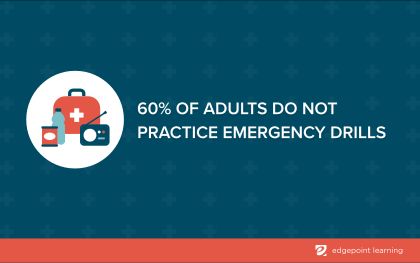How To Empower Your Employees With Crisis Management Training
Michael Hansen
🍿 5 min. read
Many workers in the U.S. are unprepared for a major workplace emergency or crisis.
How well would your employees respond to a crisis in the workplace? If you aren’t sure how to answer that question, or the answer is “not very well,” it’s time to consider adding crisis management training for all employees. Here's what it should include.
What is crisis management training?
It seems you cannot read a newspaper, surf the internet, or listen to the radio without hearing breaking news about an impending emergency or disaster.
From natural disasters to school shootings, it seems like being at work (or anywhere) is more dangerous than ever. While some groups of workers are more susceptible to violence than others, emergencies and crises can affect all people at all levels of the company.
Workplace violence is one kind of crisis, but do your employees know what to do if a fire breaks out, a building evacuation is called, or a natural disaster threatens their building? Turns out, many workers in the U.S. are not only unprepared for those emergencies but may also need emergency training for:
In schools, healthcare facilities, and other public-facing industries where vulnerable people are cared for, crisis management training is crucial to keep everyone safe, but unfortunately it's not as widespread as you might think.
A 2015 report from the Federal Emergency Management Agency (FEMA) found that 60% of adults had not practiced an emergency drill, despite the fact that 80% of people live in counties that have experienced a natural disaster since 2007.

The goal in understanding the importance of crisis management training is not to scare or concern your employees. Although there is evidence that the level of danger in the workplace is rising, some of it has more to do with the fact that we spend a third of our lives at work. And when we are in the workplace, we may be in charge of vulnerable people who cannot care for themselves.
Even if your company is not public-facing or caring for others who cannot care for themselves (i.e., children, the elderly, or the disabled), your employees need to know what to do to respond in an emergency.
What topics should crisis training cover?
The topics you cover in emergency crisis management training will vary depending on the employee’s level of involvement on the emergency crisis management team. Let's look at a few different profiles and what those employees need to know.
All employees
All employees should receive, at the very least, crisis training in evacuation and lock-down (also called lock-in or shelter-in-place) practices.
This includes where to go, who to check in with once they get there, and how to communicate with loved ones (or if they can do that). It also includes reporting procedures for getting help during a crisis.
Crisis management team
Those employees who are actively involved in crisis management and emergency preparedness should receive more in-depth training that includes, at a minimum:
- Developing plans for evacuation and/or sheltering in place
- Identifying their role in an evacuation or lockdown
- Reporting an incident
- CPR and AED use
- How to use fire extinguishers
- Steps to follow if the crisis escalates or becomes prolonged
Upper management and company spokespeople
Other crisis training topics for upper management and company spokespersons include how communication will occur with people outside of the building, and how vital operations of the company will continue during the crisis.
For example, a company spokesperson does not have to be on the premises to deliver relevant information but can instead communicate with the crisis team inside.
And what happens after a crisis has passed?
Upper management is typically involved during the recovery period that follows a significant workplace emergency. Consider what employees might do if there is a fire in their facility. How will the work still get done, and where? Who decides this? How can your company best provide support for employees who were involved in a traumatic incident? If you're public-facing, how can you best support your students or patients after an emergency?
This can (and should) also be part of the conversation during your in-depth crisis training programs.
How to roll out crisis management training
Emergency crisis management training is most visible when employees participate in drills that send them fleeing the building or gathering in assigned areas, but there's a lot more that needs to happen before that.
For example, how will employees know where to go and what to do? How will those in charge understand what they need to have readily at hand if a true emergency arises?
A training needs analysis
All of this begins with a training needs analysis. Starting here helps you to look more closely at what you are already doing well and what needs improvement or a greater focus. For example, if you are in healthcare, you probably have excellent crisis training in cardiac events, but what happens if, during a natural disaster, the power goes out?
Consider this example. In 2017, Hurricane Irma tore through Florida and knocked out power to hundreds of nursing homes, many of which did not have the necessary generators to run air conditioning and power ventilators. In the extreme heat of the Deep South, dozens of elderly patients died before power could be returned. Even in 2019, 20% of Florida’s nursing homes had not yet complied with the law that generators be present. Many were, until the days leading up to Hurricane Dorian’s thankfully mild strike, still waiting on generators.
Design strategy
Emergency crisis management training starts with deciding on which skills, abilities, and materials your employees already have, and which need to be improved upon. Once this crucial first step occurs, assigning resources in the form of time, money, and staff for developing training is the next step.
Next, what is the best method of delivery for what needs to be learned? You might start with a company-wide, in-person training to outline your goals before delivering crucial information through microlearning or eLearning courses. mLearning can be an excellent resource during an actual disaster, too.
You might also include role-playing or gamification-based activities to check employee learning throughout the year to make sure they remember what to do in case of emergency. For something as important as emergency preparedness training, it pays to develop training in a wide variety of formats to ensure everyone gets the information they need, exactly when they need it. A one-hour training could cover in-depth resources, while an easily-accessible PDF on their phone gives them a checklist to consult when a storm is rolling in.
EdgePoint Learning knows you care about the safety of your employees. If you need help getting started, need to develop a full crisis management training from scratch, or something in between, get in touch today. We can help.
